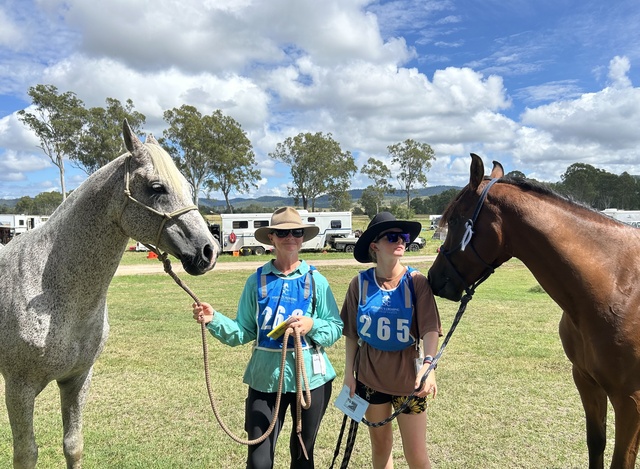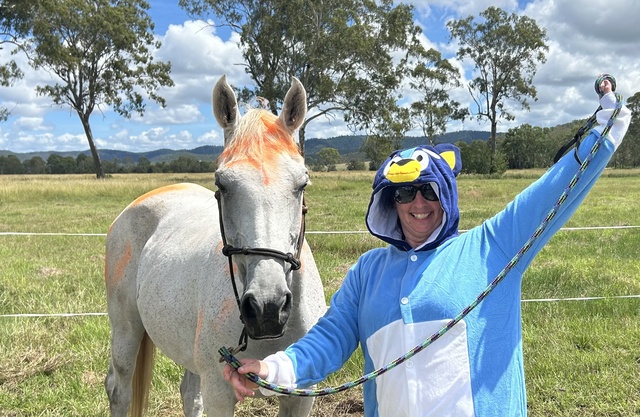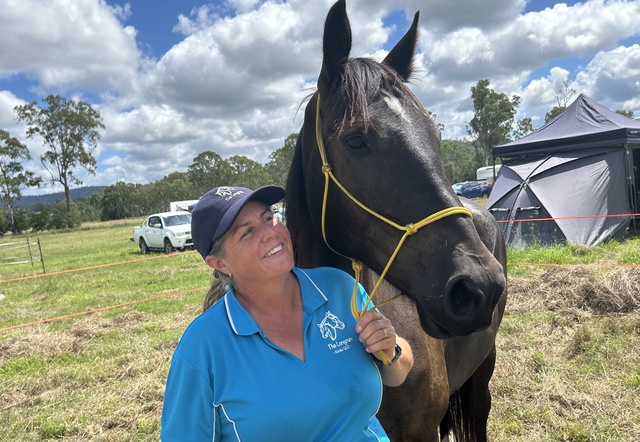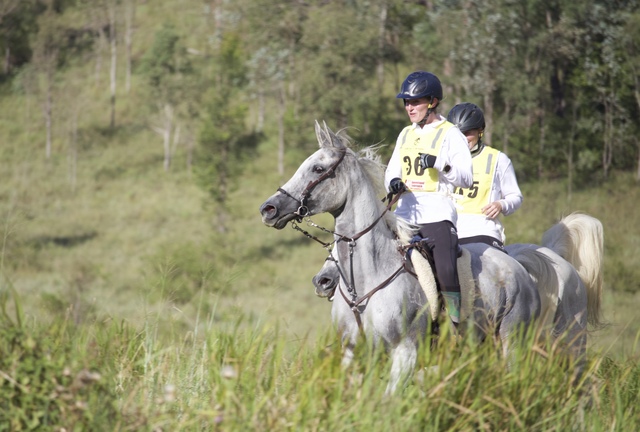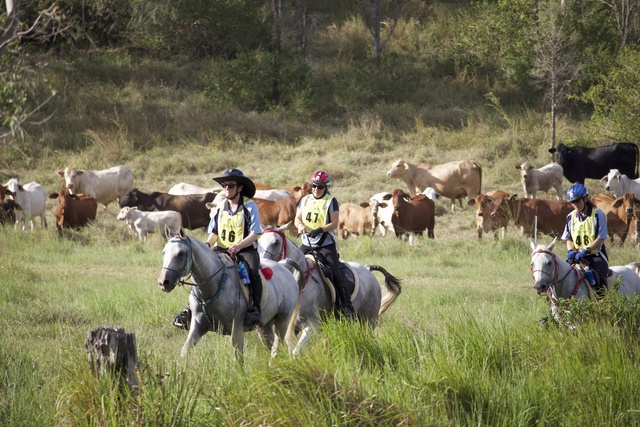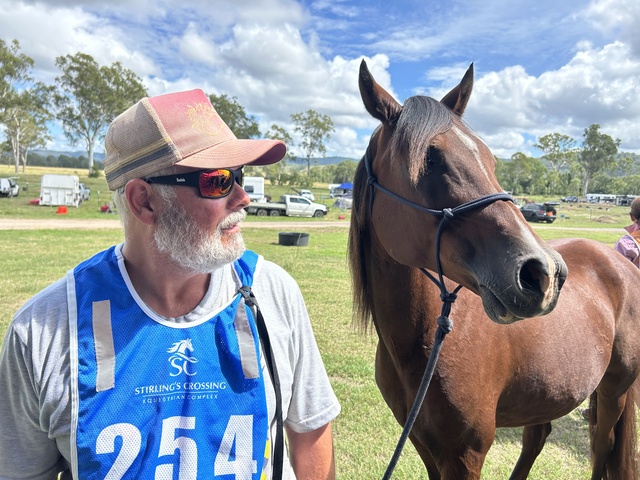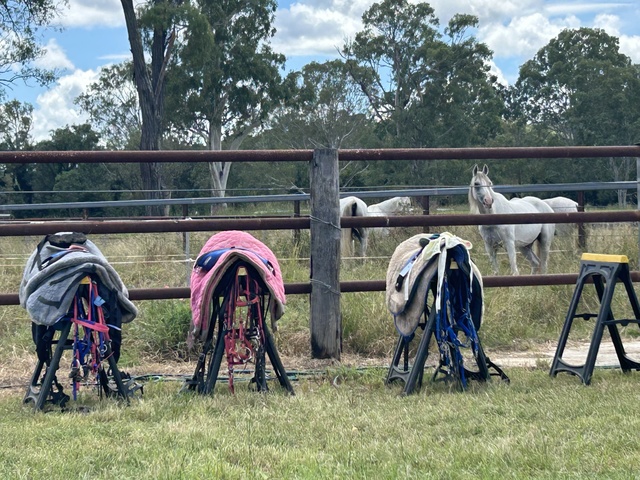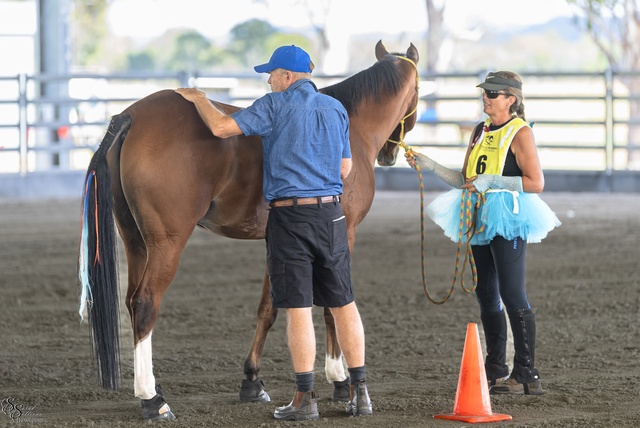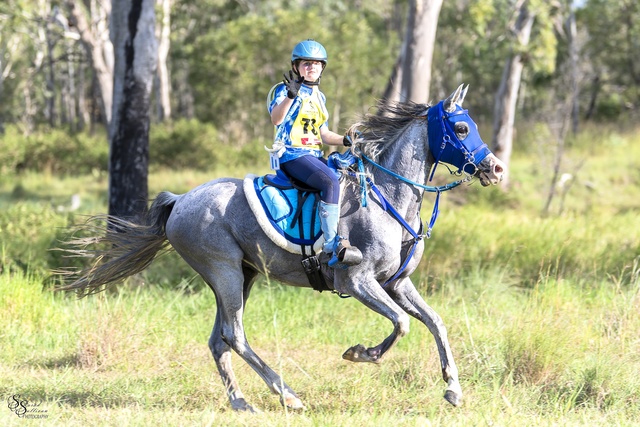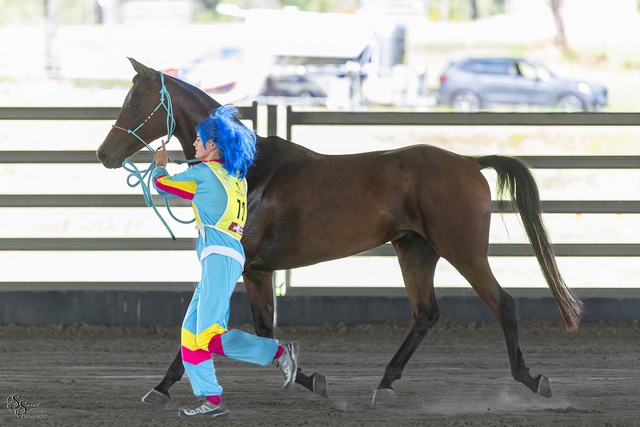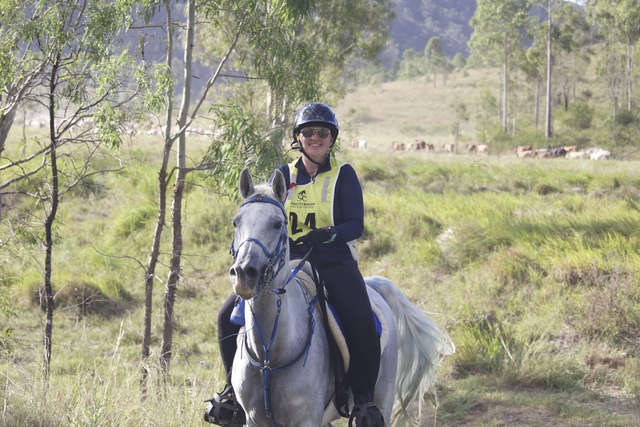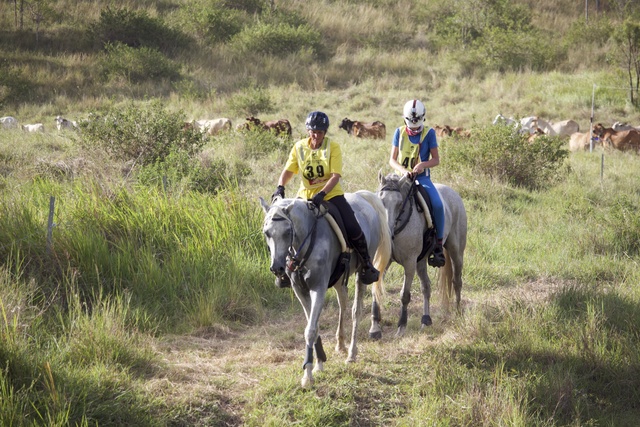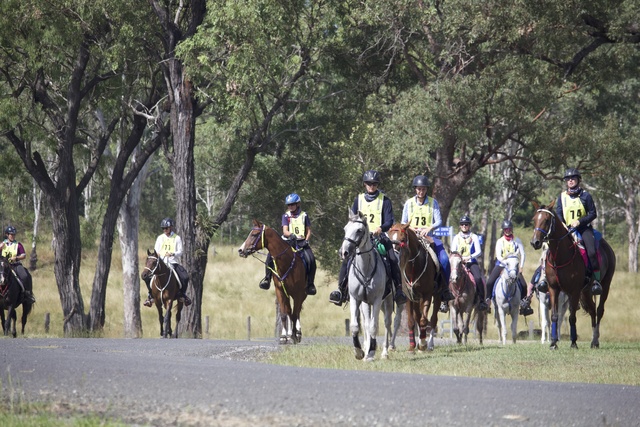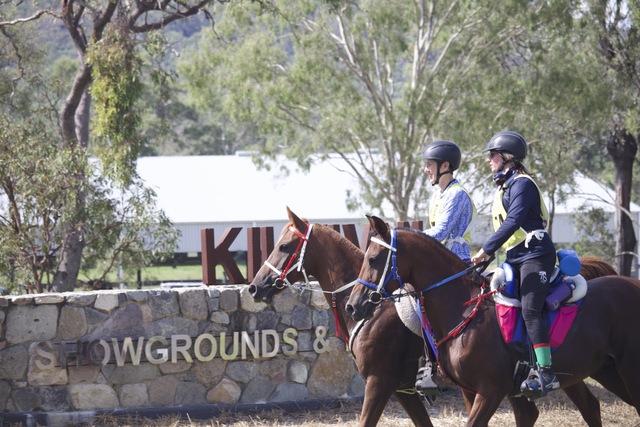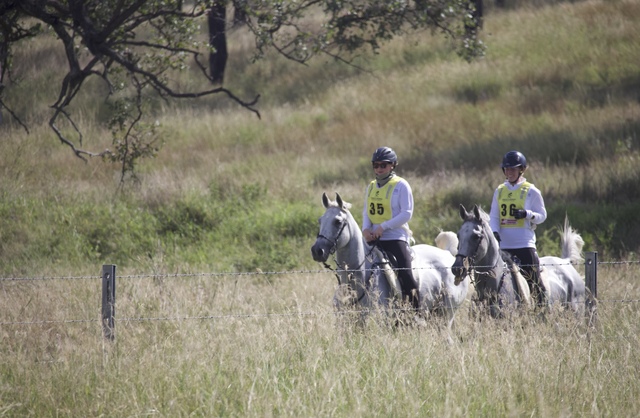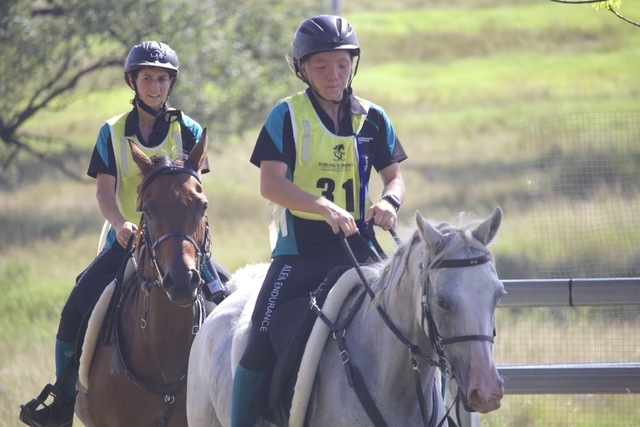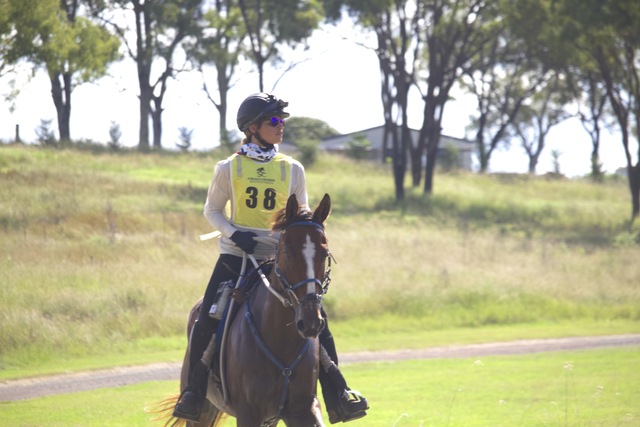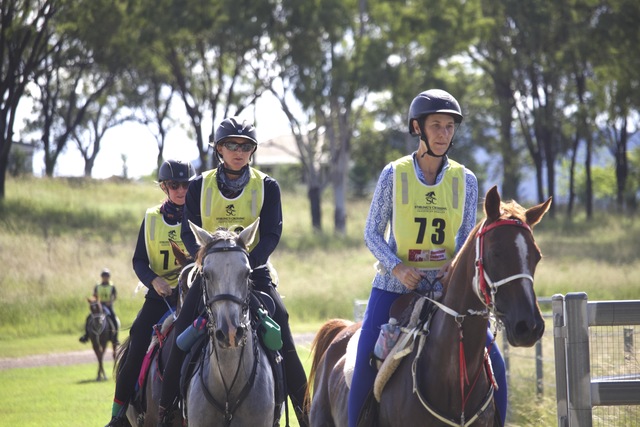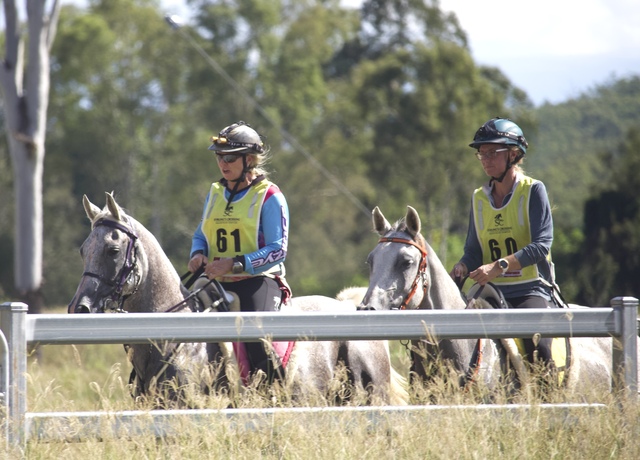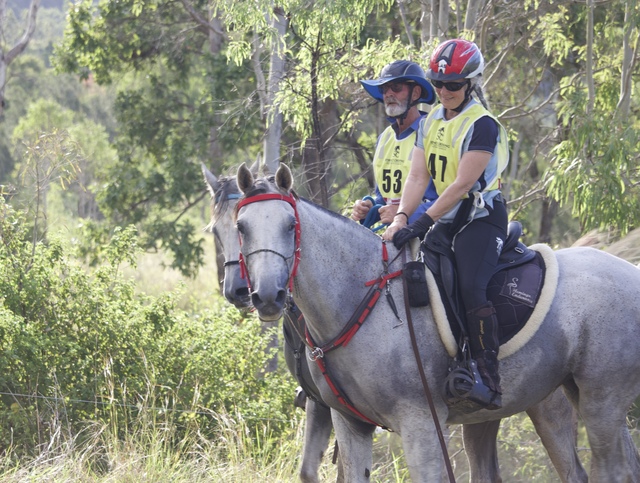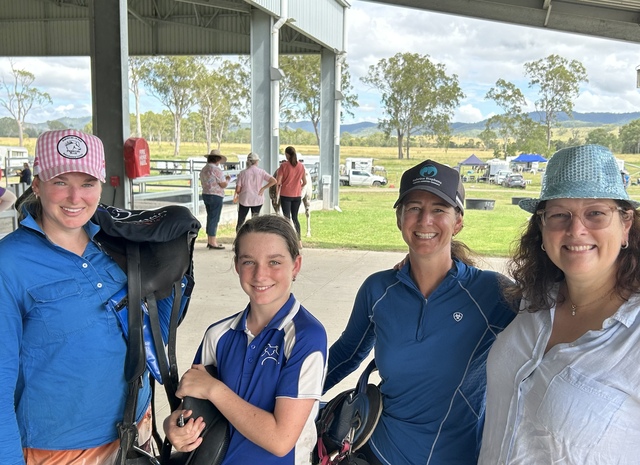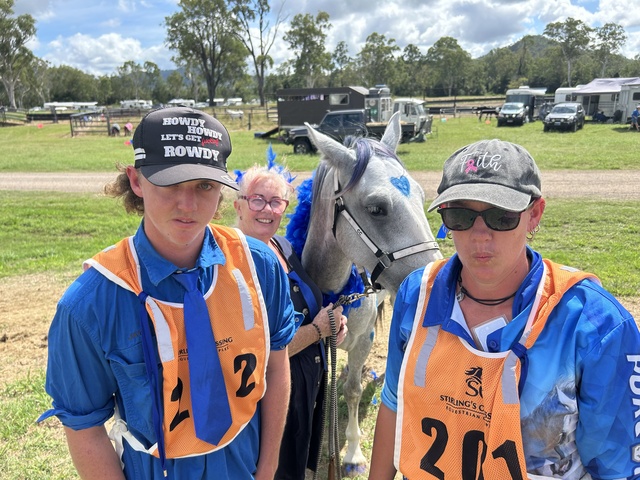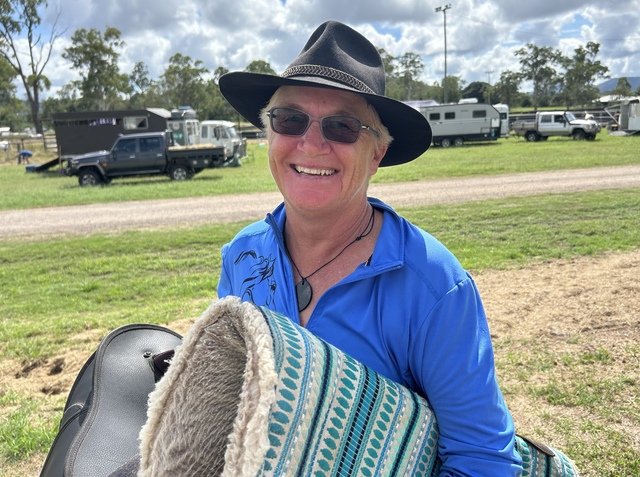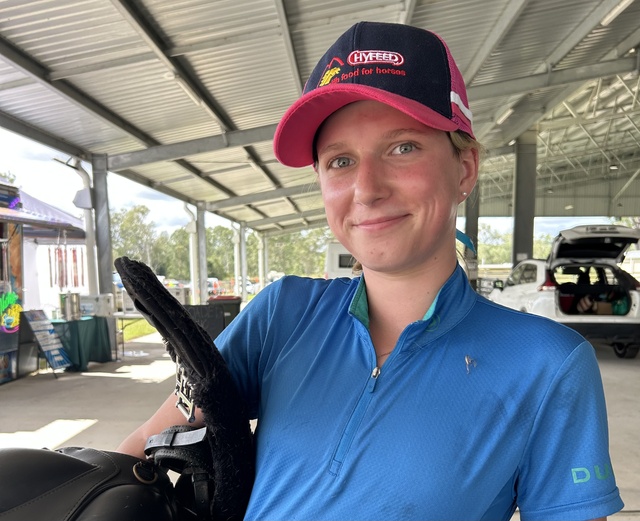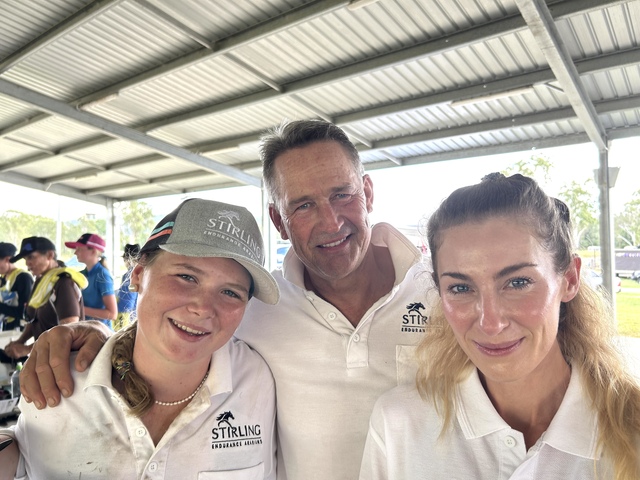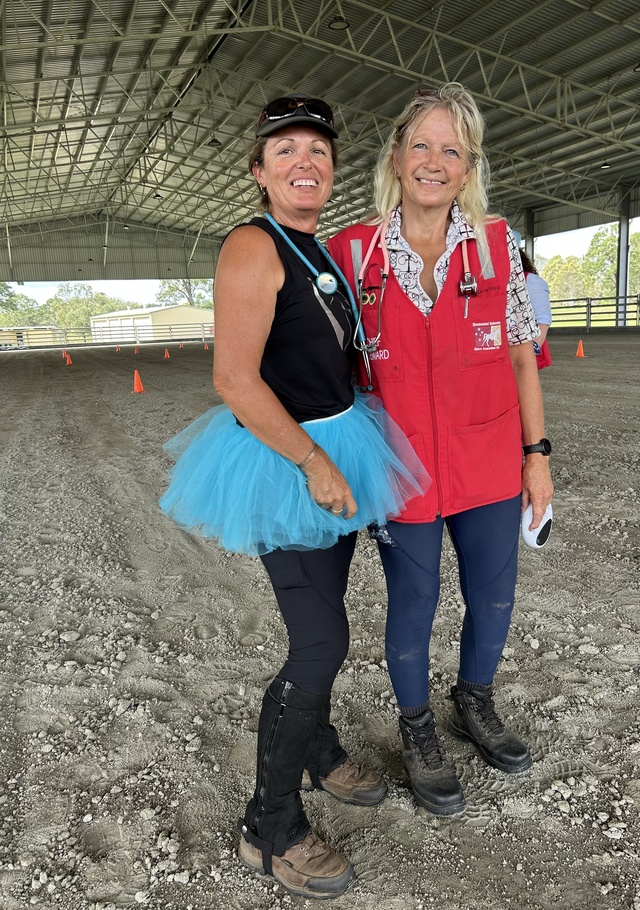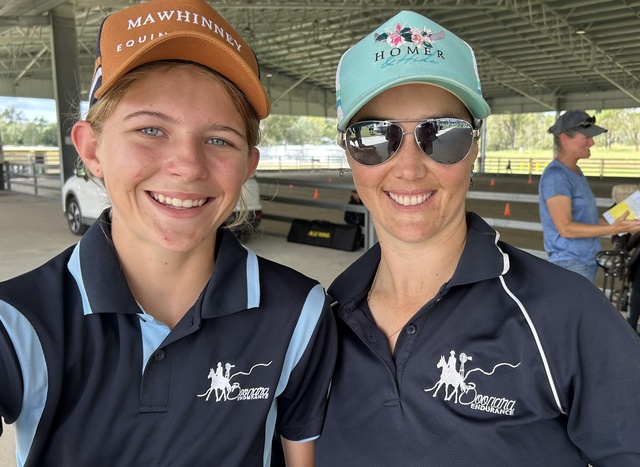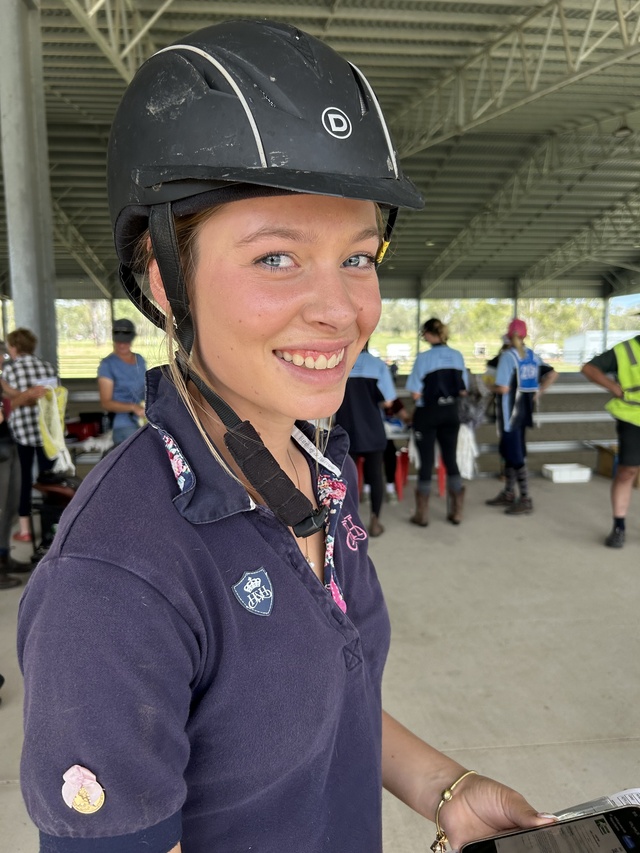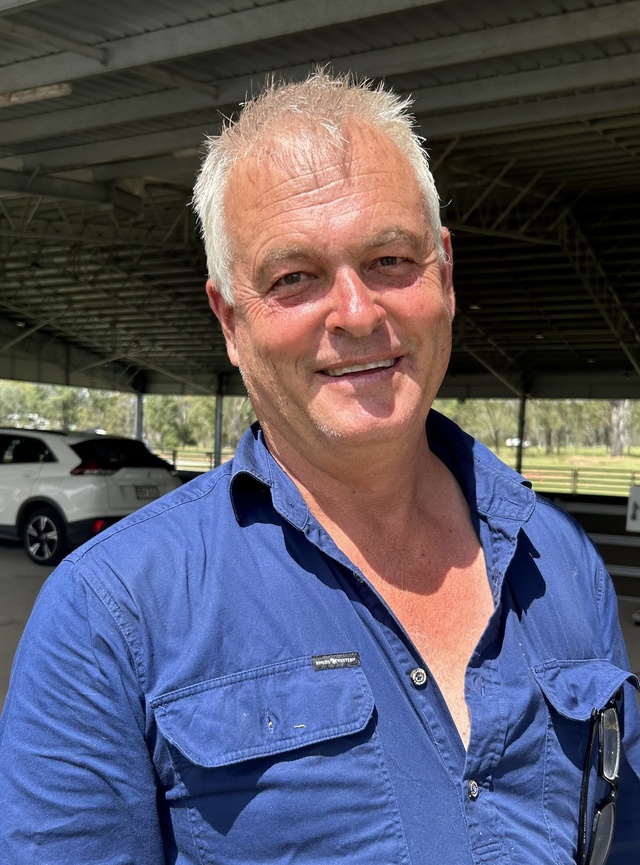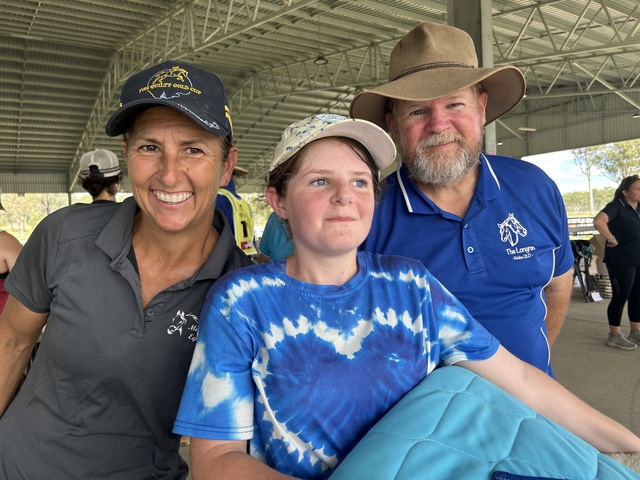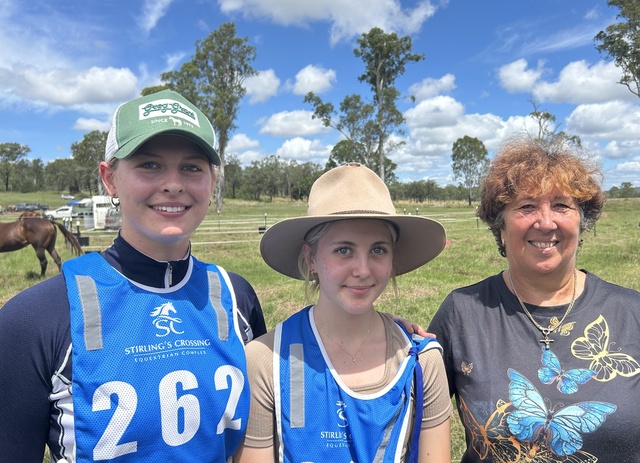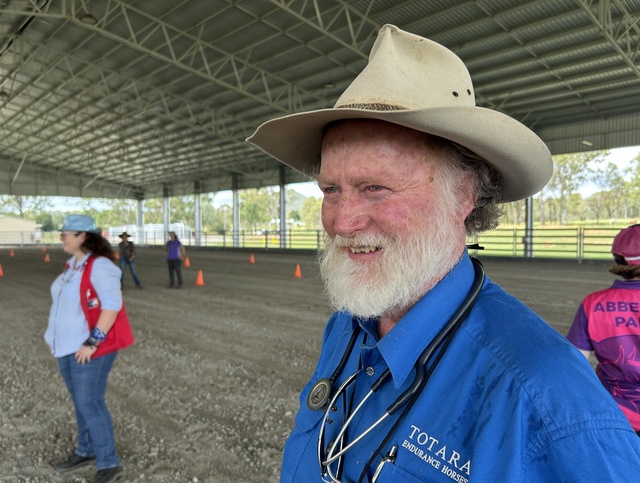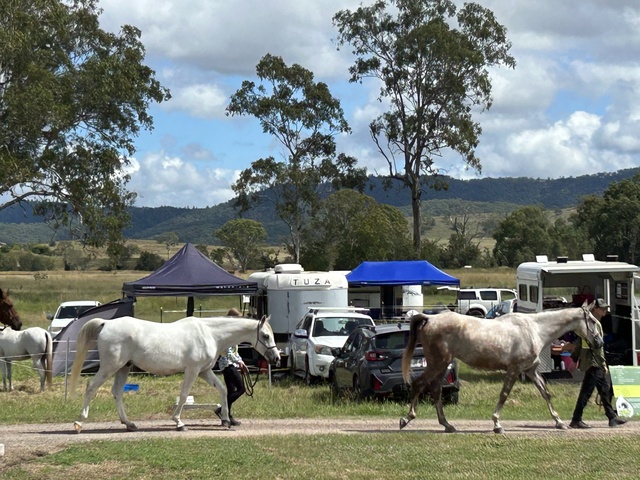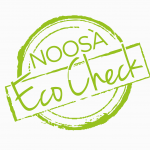You can’t have a Blue Ride without Bluey … and Bingo for that matter.
The holding of the Kilkivan Blue Ride for Men’s Health cast ripples of support that spread throughout the community, beyond the endurance horse-riding association.
Wondai’s Sue Vacher dressed as the Australia’s loveable blue heeler for the event and added dabs of orange paint to her horse to signify Bluey’s younger sister.
The Blue Ride, originally scheduled for last November but postponed due to wet weather, attracted a field of 72.
It follows the Bony Mountain Pink Ride For Breast Cancer held last month with a record field.
The Kilkivan ride saw a humid 30 degrees this time for a 2pm start.
Little wonder that Sue Vacher was keen to change from the Bluey costume into her riding gear.
“You can’t have a Blue Ride without Bluey … and Bingo,” Sue said after the initial pre-ride vet check of horses.
Cloud cover and a breeze rolled in as the field negotiated the first of three legs of the 80km course.
There were 144 acceptances for the six rides over two days – from 10km and 20km introductory rides to 40km and 80km intermediate rides.
Some of the 80km course was over country ridden in the 2013 Tom Quilty Gold Cup held at Kilkivan.
Riders were using the event to complete 80km distances for themselves or horses as they prepare for the major rides this season.
These include the Far-A-Way Easter Endurance Carnival at Imbil, the 2025 Tom Quilty Gold Cup in Tasmania early May, and the Queensland State Championships at Imbil’s Stirling’s Crossing Endurance Centre in July.
Queensland Endurance Riders Association (QERA) president Dick Collyer was pleased the association could present the Kilkivan ride.
It comes four weeks after the Pink Ride for Breast Cancer where the endurance club was able to present a cheque for $6000 to support the charity.
“It went gangbusters,” Dick said. “It was a fantastic effort.
“So many people contributed in different ways – donations, the vets, the polo club making the grounds available.”
For the Kilkivan ride he reminded that men’s health is an issue.
Events such as this encourage men to get together and talk horses when otherwise they may be reluctant to open up.
That can be the starting point and afterwards the talk becomes more general on how things are going.
“Men’s health is about awareness,” Dick said. “That’s the first step … then there’s understanding.”
A CONNECTION BUILT ON TRUST
The care of an animal can change a person’s attitude – to be more caring and respectful.
There’s a connection between horses and humans that goes back thousands of years, right to the time the wandering herds of the steppes across Asia became curious about these two-legged creatures that walked upright.
While the origin of horses dates back 40-50million years it was not until about 6000 years ago that man, the predator, formed a bond with this prey animal – even if that animal was taller and weighed 10 times more.
It’s a relationship anchored on mutual respect, understanding, and love. By dedicating time to horses, comprehending their emotions, and tending to their needs, humans can build this bond and enjoy the benefits it brings.
A post by Christa Lesté-Lasserre for Equitation Science, Human Mindset highlights that horses have no intention of harm.
Instead, there’s something compelling about their beauty, gentleness, and unassuming curiosity that pulls humans towards them and encourages the sense of touch.
“People can create a bond with a horse at first glance, sort of like they can when they meet a new person sometimes and feel that they’d like to get to know that person better and form a deeper connection,” said Erna Törmälehto, PhD candidate at the Faculty of Social Sciences at Tampere University in Pori, Finland.
Lesté-Lasserre observed nine teenagers, having no significant history with horses, spending 30 minutes in a pasture with six calm, sociable horses.
Afterwards, they spoke of the horses being “beautiful,” “peaceful,” and “calm,” and that they felt “accepted” by the horses.
And the horses stood out among other animals as offering a very different kind of relationship with the humans, due in part to their “special sensitivity and cautious curiosity.”
For Gympie rider Ken Moir there’s an attachment to horses on the physical side but also the mental side.
“There is nothing so good for the inside of a man as the outside of a horse.”
And he ought to know. Ken started riding horses at the age of three. That was in Scotland with his older brother Alex.
Now, in his 70s, he owes much of his physical and mental health to horses, particularly with endurance riding.
For Kilkivan Endurance Riders Club president Craig Ellison it was rewarding to see such numbers for the first ride at the town since 2018.
“It is a good ride,” Craig said, “with good numbers and a great track.
“This ride was designed to be held late last year and we have raised a lot of money for charity.”
An introductory endurance event was held last year as part of the Kilkivan Great Horse Ride in early April.
A 30km ride will be held as part of this year’s three-day event on April 11, 12 and 13.
TIME WELL SPENT
Mark Liesegang has used endurance horse-riding to turn his life around.
Twelve years ago Mark’s wife Natalie, a nurse, woke to find him slurring his words and struggling to string together a complete sentence.
It was a stroke and with a perfectly healthy 42-year-old man, Natalie was looking for answers.
He was diagnosed with a rare blood disorder known as thrombotic thrombocytopenic purpura, but the short-term is TTP.
After spending 10 months in and out of hospital, Mark realised that it would be something he would have to live with for the rest of his life.
In 2020 Natalie found an equine therapy course for him to participate in. That prompted them to find somewhere for Mark to learn to ride horses.
His life changed when Natalie found Virginia Barber from Mainstreme Equestrian.
Mark started to learn to ride horses, and so did his youngest daughter Maddison who was eight years old at the time.
For Natalie, who has spent countless hours supporting Mark, and now Maddie, it is “her time” by riding a six-year-old Clydesdale-stockhorse cross, King.
“It soothes my soul to see them happy and doing something they enjoy,” she said.
“I’m proud of everything they have overcome, to see what they are doing .
“Maddie is doing an 80km today. Mark did three legs of the Winton-To-Longreach ride in 2023.
“His goal is the Far-A-Away marathon at Imbil this Easter. Maddie want to do the mini marathon and then a 160km qualifier in readiness for the 2026 Tom Quilty Gold Cup when it is held at Imbil again.
“We want to go back to Longreach. We want to do one big travel a year. This year it will be the Shahzada ride near Sydney.”
Natalie has been doing trail rides with King for 18 months to support Mark and Maddison in their training.
“He will do what I want – he’s as steady as they come.
“At the moment we are trying to recognise cars and push bikes, bushes that are on the roadside.
“He gives me an inner calm. I’m kept busy and have to micro-manage others.
“He gives me my calm. Let’s me think and relax – he knows if I’m having a bad day.”
MEN’S HEALTH ISSUES
The Blue Ride is seen as a low-key strategy to engage in discussion on men’s heath.
The success of this year’s ride can be seen as the start of an ongoing campaign but done in a non-intrusive way.
Australian men are more likely than Australian women to get sick from serious health problems.
Their mortality rate is also much higher. They die in greater numbers than women.
Overall, for every two women who die, three men die.
However, Australian men generally enjoy better health and longer life expectancy than men in most other countries in the world.
In some areas, they now maintain good preventive health practices – only one in 10 men smoke daily. This is far removed from the 1920s when more than half of the young male population smoked cigarettes but that figure has progressively declined.
Today, 27 percent of men maintain recommended physical activity levels.
Mental disorders are the third most common health issue in Australia (14 per cent of the total), after cardiovascular diseases (20 per cent) and cancers (19 per cent).
Anxiety, loneliness, stress and depression are the most common factors but mental health issues may go unrecognised for a long time.
Social norms and expectations pressure men to be strong, stoic and independent. Upbringing and role models can teach them to cope with problems by themselves or use unhealthy coping mechanisms.
There can be a feeling of being embarrassed to seek out help, as well as a lack of awareness about the signs and symptoms.
It’s about taking best care for yourself to enjoy your life, and not being ill.
You wonder how people get over some of the things life hands out. Yet then you realise that everyone has issues to deal with.
It’s about taking the time to reach out and ask: “Are you OK?”
2025 KILKIVAN BLUE RIDE RESULTS
80km Saturday Ride:
Heavyweight: 1. Andrea Dunsby, County Downs Optical Illusion, 7:05:27. 2. Troy Butler, Falcon Hill Mahbeer, 7:12:38 (best conditioned horse).
Middleweight: 1. Charlotte Williamson, Stirling’s Hutcho, 6:54:35 (best conditioned horse); 2. Tim Humphries, Aloha Sweet Rose, 6:56:00; 3. Steve Gray, Shardell Indian Storm, 7:02:06.
Lightweight: 1. Nikki Sample, Brookleigh Danu, 6:54:34 (best conditioned horse); 2. Mary Duncan, Kobalt Elton, 6:55:58; 3. Brooke Marshall, Thunder Ridge Shadow, 7:09:00; 4. Giulia Ciprino, Shakeel Glow, 7:09:25.
Junior: 1. Ella Stanton, Boonara Dark Ruby, 8:16:34 (best conditioned horse); 2. Levi Berryman, Cohburn, 8:24:16. 3. Taylor Grogan, S’Shaada Canadian Club, 9:00:06.
TASMANIA TOM QUILTY QERA STATE TEAM 2025
The QERA Selectors will consider all horse/rider combinations who nominate for the TQ Tasmania 2025 event on May 10-12.
However, riders must advise if they would like to be selected or be included in another team.
Riders must have nominated as a combination by the closing date at 10pm on Wednesday, 30 April.
The selection panel will consider the following points when choosing the team:
· Horse and rider’s combined experience and success in endurance;
· Rider’s commitment to a positive team environment and horse welfare;
· The suitability of the horse/rider combinations fitness and soundness with regards to 160km competitions.
The selection panel will select a team of four members plus one reserve. There will be a supplementary list of combinations in case several of the selected team do not make it to the event or fail the pre-ride vet check.
All QERA combinations who have entered for the event will be contacted by the selectors and be informed of the outcome of the selection process one week prior to the event start.

